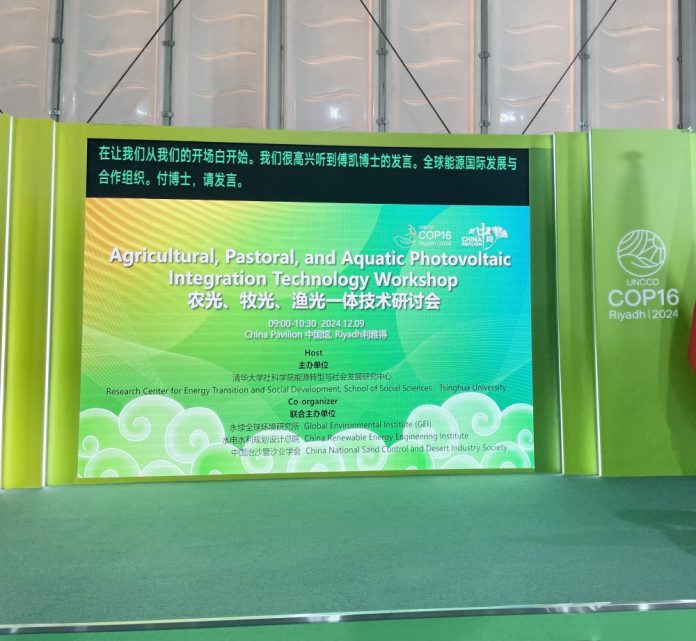The side event of “Agricultural, Pastoral, and Aquatic Photovoltaic Integration Technology Workshop” was held in the China Pavilion in the blue zone of the COP16 venue in Riyadh, Saudi Arabia on the morning of December 11. The seminar was hosted by the International Energy Network and sponsored by the Center for Energy Transition and Social Development, School of Social Sciences, Tsinghua University, and co-sponsored by Global Environmental Institute (GEI),China Renewable Energy Engineering Institute, China National Sand Control and Desert Industry Society and International Energy Network.
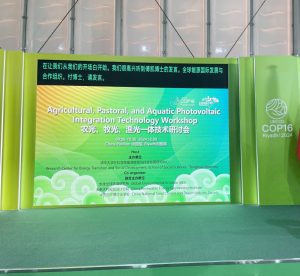
Those Participants who delivered speeches in the seminar included Prof. Lu Qi, President of Institute of Great Green Wall China, Mr. Li Jie, Vice-president of Forest and Grassland Survey and Planning Institute of National Forestry and Grassland Administration, He Jijiang, He Jijiang, Deputy director of Research Center for Energy Transition and Social Development in School of Social Science of Tsinghua University, Zhang Jiali, Vice President of Renewable Energy Research Institute, China Renewable Energy Engineering Institute, Yang Wenbin, Executive Vice-President and Secretary-General of China National Sand Control and Desert Industry Societ of Chinese Academy of Forestry, Lin Jinglan, Assistant of the Energy and Climate Change Project at the Global Environment Institute (GEI), Liao Jie, Deputy Director of the S&R Management Office in Northwest Institute of Eco-Environment and Resources of Chinese Academy of Sciences, Tuo Xiangyin, General Manager of Ningxia Yuansheng Luyang Forest and Grass Ecological Engineering Co., Ltd, Liu Wen, Professor of University of Science and Technology of China, Bao Encai, Associate Researcher of Jiangsu Academy of Agricultural Sciences, and Liu Jian, an Associate Professor at Hainan University.
The seminar shared the challenges, coping strategies and current major research results faced by composite photovoltaic projects such as agricultural photovoltaic, pastoral photovoltaic and fishery photovoltaic.
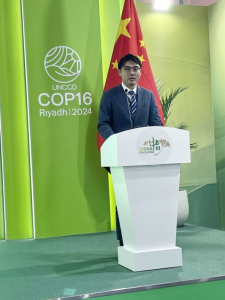
Fu Kai, Global Energy Interconnection Development and Cooperation Organization
At the beginning of the meeting, Dr. Fu Kai of the Global Energy Interconnection Development Cooperation Organization delivered a speech. He said that the world is facing serious crises and challenges. Resource shortages, climate change, environmental pollution and loss of biodiversity seriously threaten human survival and sustainable development. The root cause of the crisis is large-scale consumption and heavy reliance on fossil energy. The key to solving the crisis is to develop clean energy and accelerate the green and low-carbon transformation.
The Global Energy Internet Development Cooperation Organization (GEIDCO) was established in 2016. It is a non-governmental, non-profit international organization voluntarily formed by relevant enterprises, organizations, institutions and individuals committed to promoting the sustainable development of world energy. Its mission is to promote clean development and build a harmonious world.
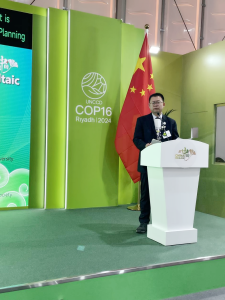
He Jijiang, Deputy director, Research Center for Energy Transition and Social Development, School of Social Science, Tsinghua University
Dr. He Jijiang, Deputy director, Research Center for Energy Transition and Social Development, School of Social Science, Tsinghua University, introduced the preparations for this side meeting. He said that the side meeting was jointly participated by the energy department and the ecological environment department, highlighting the importance of photovoltaics empowering land and people. In this regard, he gave an example that one mu of land is 660 square meters, and a 60kW photovoltaic power station can be installed, generating 100,000 kWh of electricity per year, with an income of about 30,000 yuan. This combination of land and photovoltaics has greatly improved the efficiency of land use. In order to achieve carbon neutrality around 2050, the world needs 10 kilowatts of renewable energy per capita, of which about 7 kilowatts comes from photovoltaics. If the global population is 8 billion, the installed capacity of photovoltaic power will reach 80 billion kilowatts, requiring 800,000 square kilometers of land. These lands can be open fields, water surfaces, or desert wastelands, or building roofs.
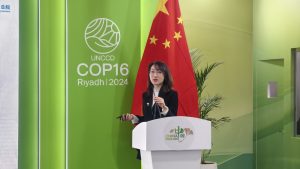
ZHANG Jiali, Vice President, Renewable Energy Research Institute, China Renewable Energy Engineering Institute
In the keynote report session, ZHANG Jiali, Vice President, Renewable Energy Research Institute, China Renewable Energy Engineering Institute, took the theme of “The Road to High-Quality Development of China’s Solar PV Industry” and gave a detailed introduction to the current development status of China’s photovoltaic industry and the situation and challenges it faces, and put forward four suggestions: adhere to the common development of centralized photovoltaic power stations and distributed ones; continuously improve the “photovoltaic + energy storage” development model; explore multi-scenario applications, multi-energy complementarity, and integrated development of source, grid, load and storage; continue to promote the advancement of photovoltaic power generation technology.
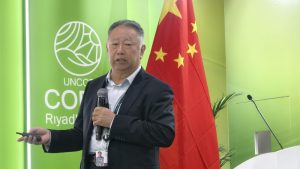
Yang Wenbin, Executive Vice-President and Secretary-General, China National Sand Control and Desert Industry Societ, Chinese Academy of Forestry
Yang Wenbin, Executive Vice-President and Secretary-General, China National Sand Control and Desert Industry Societ, Chinese Academy of Forestry, focused on introducing China’s sand control and sand control technology. He pointed out that in the process of building photovoltaic power stations in desert areas, problems such as deterioration of original soil, landforms and vegetation, and intensified wind and sand movement are faced. During the operation and maintenance process, we have to face the risk of crushing vegetation and soil, and easy dust and wind erosion. In this regard, Secretary-General Yang Wenbin proposed the sand fixation method of feather bag sand barrier. This method is based on low-coverage sand control, and innovatively invented a composite sand barrier with bottom bags to fix sand and feather waves on the top of the bag to block wind and weaken wind energy. This method not only reduces costs, but also significantly reduces the damage to the original soil, landforms and vegetation caused by field leveling, and reduces the cost of sand control by about 50%.
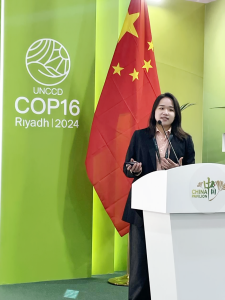
Lin Jinglan, Project Assistant, Energy and Climate Change at the Global Environment Institute (GEI)
Lin Jinglan, Project Assistant, Energy and Climate Change at the Global Environment Institute (GEI), shared the development status and cases of agricultural photovoltaic, pastoral photovoltaic and fishery in China, and analyzed them. Lin Jinglan summarized the two major challenges faced by composite photovoltaic projects such as agricultural photovoltaic, pastoral photovoltaic and fishery photovoltaic complementarity. First, because photovoltaic power stations are mainly built on wasteland, the soil fertility is poor, and it takes a long time and a large investment to protect them. This is a huge challenge for agricultural companies. Second, the problem of consumption. The west faces the challenge of power generation exceeding power consumption. Therefore, Lin Jinglan suggested introducing long-term cooperation mechanisms and insurance to attract social capital investment.
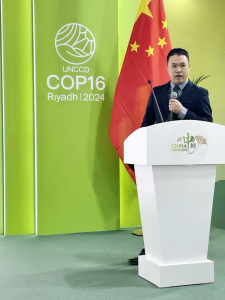
Liao Jie, Deputy Director of the S&R Management Office, Northwest Institute of Eco-Environment and Resources, Chinese Academy of Sciences
Liao Jie, Deputy Director of the S&R Management Office, Northwest Institute of Eco-Environment and Resources, Chinese Academy of Sciences, delivered a theme report entitled “Sustainable Land Management in Sandy Areas–Policy, Water, Ecology, Agriculture, New Energy”.
Liao Jie said that sustainable land management (SLM) is essential for environmental health, social well-being, and economic development. It emphasizes the need for sustainable land management practices to address land degradation, ensure the resilience of ecosystems, and support long-term sustainable development. It has an important impact on environmental protection, climate change mitigation, food security, water resources management, economic development, biodiversity protection, and disaster risk reduction.
China has made great achievements in desertification control over the past 60 years, but it also faces many challenges: first, the harsh natural environment, including low precipitation and high evaporation, strong winds and dust weather, and low fertility of sandy soil. The second is the serious problem of desertification and salinization. These farmers’ incomes have declined, and a large number of young people have left the countryside to decline. The Northwest Institute of Eco-Environment and Resources, Chinese Academy of Sciences, has developed a water-saving, high-value-added, and environmentally friendly crop variety – desert morel. Organically combine the cultivation of morels with photovoltaics to achieve the purpose of protecting the environment, improving livelihoods and enhancing the capacity of social systems.
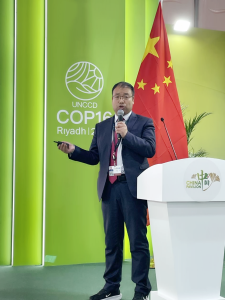
Tuo Xiangyin, General Manager of Ningxia Yuansheng Luyang Forest and Grass Ecological Engineering Co., Ltd.
Tuo Xiangyin, Senior Engineer of Ningxia Yuansheng Lvyang Forest and Grass Ecological Engineering Co., Ltd., delivered a keynote speech on the theme of “Desert Land Ecological Management Project”. He said that with the increasing demand for desertification control in various places, the demand for sand-dwelling plant seeds in various places is also rising. Caragana, flower stick, Yangcha, Populus euphratica, Hippophae rhamnoides, Salix psammophila, Calligonum mongolica, Ammopiptanthus sutchuenensis, Haloxylon ammodendron, etc., in the aspects of national land greening, desert control, soil and water conservation, vegetation restoration, road and railway slope protection, airport and lake dam ecological protection, these seeds have the characteristics of low price, suitable growth and sustainable use. Yuansheng Lvyang will continue to improve product quality and service, “pay attention to every seed”, from seed collection-collection-drying-processing and selection-packaging-sampling-warehousing-sales-transportation-pre-sales and after-sales service. Strive for reliable quality, sufficient supply, fast circulation and customer satisfaction.
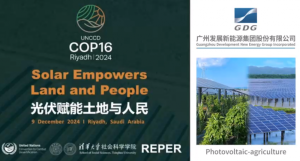
Guangzhou Development New Energy Group Co., Ltd. presented the solutions and cases of new energy to help the ecological restoration of rocky desertification land in the form of video.
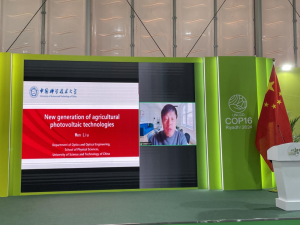
Liu Wen, Professor of University of Science and Technology of China
Professor Liu Wen of University of Science and Technology of China delivered a theme report on “New Generation of Agricultural Photovoltaic Technologies” in the form of video. Professor Liu Wen pointed out that for crops under photovoltaic panels, production is often affected by insufficient light. For this reason, he proposed three solutions, one of which is to use translucent photovoltaic panels. The second is to install lighting equipment under ordinary solar panels. The third is to use a tracking bracket system to reflect sunlight and take into account power generation and crop growth.
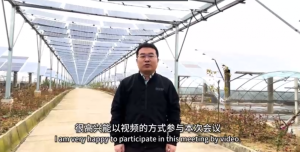
Bao Encai, Associate Researcher of Jiangsu Academy of Agricultural Sciences
Associate Researcher Bao Encai of Jiangsu Academy of Agricultural Sciences and his team have been committed to exploring how photovoltaics can be closely integrated with modern agriculture, improve agricultural productivity, reduce environmental impact, and promote green development of agriculture. At this seminar, Researcher Bao Encai shared a theme report on the Research and Application of Key Technologies for Green and Low-Carbon Production in Photovoltaic Agricultural Parks.
He pointed out that the contradiction between photovoltaic power generation and agricultural production is a prominent problem restricting the development of photovoltaic agriculture. This technical model relies on more than 30 vertical and horizontal projects, explores the annual light and temperature distribution law in the agricultural photovoltaic system, adopts the temperature and humidity environment control strategy, creates a new agricultural photovoltaic complementary building integrated structure, screens crop varieties suitable for photovoltaic production, and establishes an agricultural photovoltaic high-efficiency and stable production planting technology system. The agricultural output can reach more than 80% of the average level under open-air conditions in the same region, and the comprehensive utilization efficiency per unit of land is increased by 3 times.
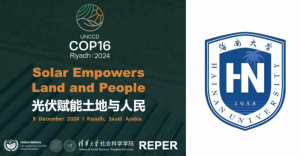
Associate Professor Liu Jian of Hainan University participated in the conference via video
The team of Associate Professor Liu Jian of Hainan University has been deeply involved in the field of photovoltaic greenhouses for 11 years, and has obtained 3 photovoltaic greenhouse-related patents, developed hot zone photovoltaic greenhouses (5 types of standard greenhouses), and more than 20 photovoltaic greenhouse (greenhouse) consulting and design projects with a total investment of 10 billion yuan. At this seminar, Associate Professor Liu Jian discussed the practical innovation results of photovoltaic greenhouses in China’s hot zone.
Overall, scientists, government officials, social organizations, and corporate representatives gathered at this seminar to discuss the feasibility of photovoltaic + agriculture, fisheries, and animal husbandry, and share the latest research results. The successful convening of the seminar has pointed out the development direction for photovoltaics to empower land and people and to solve the ecological and environmental protection in agriculture, rural areas and pastoral areas.





